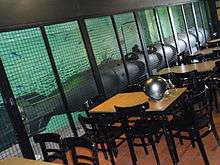Chariot manned torpedo


The Chariot was the British design of the manned torpedo used in World War II. The British Chariot was inspired by the operations of Italian naval commandos. The Chariot was carried to an area of operation on a submarine, and launched underwater, carrying two frogmen into action. The Chariot would enter an enemy harbor; the frogmen would place limpet mines on enemy ships, and return to the submarine.
Design
- Chariot Mark 1, 6.8 m (22 feet 4 inches) long, 0.9 m (2 feet 11 inches) wide, 1.2 m (3 feet 11 inches) high, speed 2.5 knots (4.6 km/h), weight: 1.6 tonnes, maximum diving depth: 27 m. Endurance 5 hours (distance depended on water current). Its control handle was shaped like . 34 were made.[1]
- Chariot Mark II, 30 ft 6 in (9.3 m) long, 2 ft 6 in (0.8 m) diameter, 3 ft 3 in (1 m) maximum height, weight 5200 pounds (2359 kg), max speed 4.5 knots, range 5–6 hours at full speed, had two riders, who sat back to back. 30 were made.[2]
Both types were made by Stothert & Pitt, crane makers at Bath, Somerset.
Use in action
British operations with Chariots were not as successful as Italian operations had been. In fact, "the only completely successful British Chariot operation" occurred on 28–29 October 1944. Two crews on Mk II Chariots, commanded by Lieutenant Tony Eldridge RNVR, were launched from the submarine HMS Trenchant and sank two ships in the harbour of Japanese-occupied Phuket, Thailand.[3]
See also
Notes and references
- ↑ O'Neill, Richard (1981). Suicide Squads: Axis and Allied Special Attack Weapons of World War II: their Development and their Missions. London: Salamander Books. p. 296. ISBN 0 861 01098 1.
- ↑ Hobson, Robert W. Chariots of War Ulric Publishing, Church Stretton, Shropshire, England, 2004, ISBN 0-9541997-1-5. Pages 61-62
- ↑ As described by Lieutenant Eldridge in his account of the attack. Thompson, Julian. "The Royal Navy in the Second World War" in The Imperial War Museum Book of the War at Sea. Sidgwick & Jackson 1996. Pages 245-246.
External links
![]() Media related to Chariot manned torpedoes at Wikimedia Commons
Media related to Chariot manned torpedoes at Wikimedia Commons